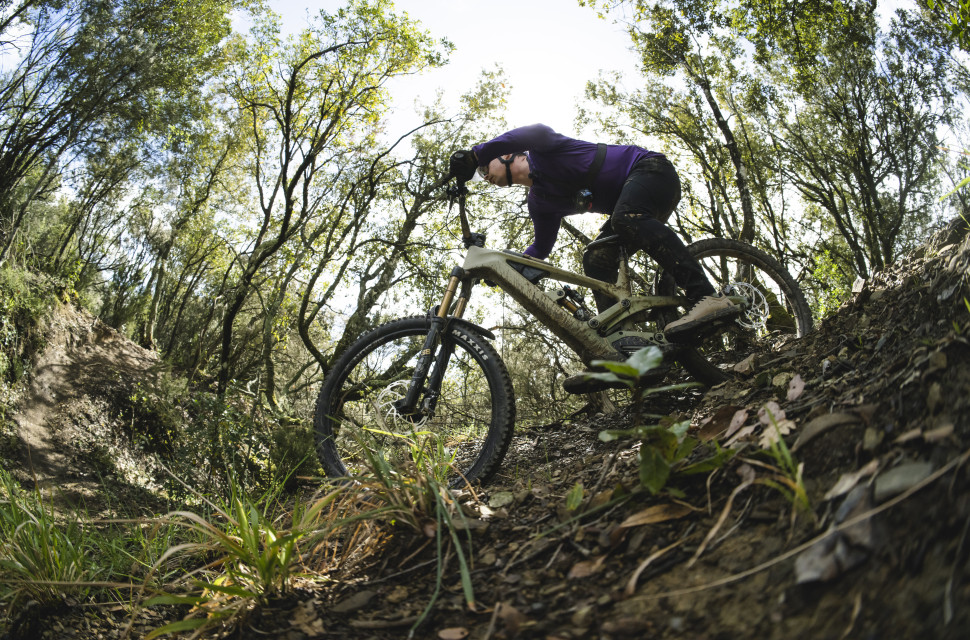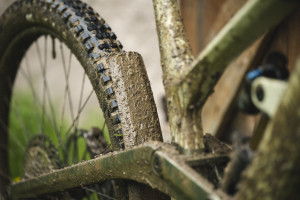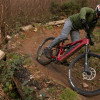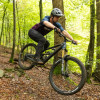Mountain biking in the rain - how to ride in muddy conditions

Wet trails are mountain biking's greatest leveller. Slick conditions where traction is non-existent pose some of the most difficult riding of the year, and this is where solid riding techniques come to the fore. Because there's no grip, small mistakes are magnified, but mastering riding in the rain will keep the stoke high, whatever the weather.
- Five tips to make winter cycling easier
- How to set up your mountain bike for winter
- Best winter cycling gloves 2025 - warm mountain bike gloves
Even though riding in wet and slippery conditions is more difficult than when it’s dry, it’s the best place to hone your skills. Learning to master wet trails will pay back in dividends when the trails dry out as all of the skills and techniques we’re going to talk about will translate perfectly to dry tracks, where grip and traction are higher.
Look up, look ahead and scan the trail
Looking where you’re going is a fundamental technique of mountain biking regardless of the conditions. Looking far down the trail is the best way to scan what’s coming and ready yourself before a feature hits your front wheel. If you’re busy watching your front wheel, you’re not giving yourself time to react.
Looking ahead is even more important when riding in the wet. Where in the dry you’re looking for roots, rocks, and the perfect line, winter riding throws puddles into the mix, so you’re also looking and predicting where grip should be found.
In the winter and any conditions, fixating on something you don’t want to hit, like a puddle or a patch of slop can cause you to ride into what you’re trying to avoid – where you look is where you'll go. This will often destroy flow during a descent and slow you down dramatically.
Stay loose, avoid stiffening your body
Keeping your eyes up will help you stay relaxed and loose on the bike which is imperative to grip in general. Allowing the bike to move around freely underneath you will help it do part of the job for you, as it slips, grips and adjusts to imperfections in the trail.
Riding with a stiff posture on the bike will limit the way it rides in general, throwing weight around in the wrong ways and encouraging your bike to break traction. If you stay stiff as your bike breaks traction, you’ll drastically limit its ability to regain grip by forcing weight through it. If you loosen your posture on the bike, the wheels and tyres will move around more freely, enabling them to hunt for grip. Yes, a bit of a slip can be scary, but stiffening will only exaggerate the problem. Staying loose will mean that most lapses of grip will remain momentary.
Plan your braking
As trails are wetter and softer, grip isn’t as readily available so you’ll need to start braking earlier to modulate your braking power properly. This will allow you to retain traction as you slow. Pulling too hard on your brakes will lock up your wheels, which reduces control over the bike and it won’t slow you down nearly as efficiently.
Another benefit of looking up is the ability to plan your braking properly. In the wet, braking distances vary depending on the surface and, as many bikes aren’t equipped with ABS, it’s important to map out where you should brake for the best results on the fly.
Over wet trails, it’s not often that you’ll get a choice but, before slamming on the brakes, look for a harder section of trail which will reward you with more traction. When braking over a harder surface, you’ll be less likely to lock up your wheels and the braking distance will be marginally shorter. If you’re braking through a soft section of trail, as before, start braking early and modulate your braking power to keep your wheels rolling, and gripping.
Keep your momentum
Riding through mud is slower and requires much more effort to pedal up to speed, so retaining any momentum you already have is imperative to an easier time on the bike. There are other benefits to momentum, too, as it’ll help your tyres clear mud and better grip the trail. It’ll help you drive through sticky and rough sections, rather than get bogged down all the while saving energy for the next trail.
To keep your wheels rolling, pump the terrain and be careful not to over-brake. Remember to look up to anticipate any areas where you’ll need to slow down and pick the best line possible.
Pedal smoothly
Where grip is inconsistent, you’ll have to be wary of how you’re pedalling to keep good traction and forward momentum, and this applies to climbing and descending. Pedal too hard or too sharply, and you’ll spin the rear wheel, sucking momentum and wasting energy.
Instead, you can either slow your cadence (the speed at which you pedal) or shift into a slightly harder gear, which will do the same thing without sacrificing speed. Pedalling in circles while pulling backwards and up on your pedals will help smooth out your pedal stroke, too. This is where riders choose to ride with an oval chainring, as it smooths your pedal stroke for you.
Hone your cornering technique
Employing the correct cornering technique for flat corners will give you the most available grip, but also allow you to make adjustments and stay better balanced should your wheels lose traction.
Dropping your outside foot and leaning the bike underneath you, rather than using your body weight like a motorcycle, gives you space for the bike to move freely. But importantly, it puts your body in a stronger position when your tyres slip, meaning you can stay upright on the bike and keep control of a slide, rather than encourage the slide through improper body position.
Weight the front of the bike
Modern mountain bikes come with long front centres which do great things for stability and support, especially when the trail gets steep. However, bikes with such geometries need a tweak in riding style to get the most out of them when cornering and rings particularly true in winter. It’s all well and good having the rear wheel slip as that can be controlled but losing traction at the front wheel can result in a crash.
Many new riders tend to ride with their weight further back on the bike, which reduces weight and grip on the front wheel. Without weighting the front wheel, you'll likely wash out over loose and sloppy sections.
To improve front-end stability, bend your elbows and lower your chest to the handlebar. This will add more weight to your front wheel and increase grip – experiment with this until you feel comfortable. More weight on the front of the bike will help everywhere. In corners, you'll have more grip and when tackling steep terrain, you'll receive better traction when on the brakes. Riding with bent arms will also increase your range of movement over the bike whether cornering or negotiating technical sections.

















